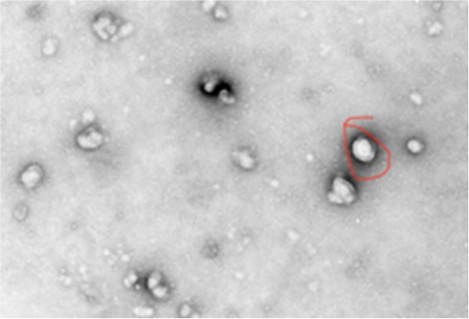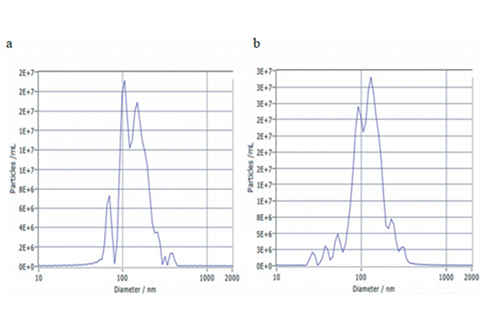
Exosomes are cystic vesicles with a double-membrane structure, with a diameter of 30nm-100nm, which originate from late endosomes in the endocytic system of cells and are widely present in various body fluids , including blood, saliva, urine, cerebrospinal fluid, semen, breast milk, amniotic fluid, ascites, vaginal/alveolar lavage fluid.
Due to the special structure and function of exosomes, it can be used as a biomarker for the diagnosis and treatment of diseases because of its high value. And it may also be used as a natural carrier of medicines for treatment in the future. Relevant studies have shown that exosomes play an important role in the diagnosis and clinical treatment of many diseases such as cell communication, cell migration, tumor formation, tumor metastasis, nervous system, and cardiovascular system.

 Electron micrograph
Electron micrograph
 NTA particle size tracking
NTA particle size tracking
Journal: Aging Cell Impact factor: 7.238 Published date: March, 2018 Published by: Chinese People's Liberation Army General Hospital
Osteoporosis and osteopenia affect people's health, especially in the elderly. The mechanism of bone regeneration is the main cause of osteoporosis and osteopenia. Recent reports suggest that bone-associated exosomes are involved in regulating bone remodeling by regulating the transfer of key molecules required by osteoclasts, cells and osteoblasts. With the prevalence of antibiotic resistance, there is an urgent need to change the structure and improve the activity of antibiotics. Many natural product biosynthetic gene clusters have been found in genome and metagenomic sequencing data. These gene clusters contain many unknown molecules.
However, the comprehensive changes in serum-derived exosomes (SDEs) proteins in elderly patients with osteoporosis or osteopenia and their roles in bone remodeling remain unclear. The authors extracted exosomes from the serum of patients with osteoporosis, osteopenia, and normal volunteers, and analyzed them quantitatively using TMT proteomic technology.
 Figure 1 Experimental technical route
Figure 1 Experimental technical route Figure 2 Quantitative proteomics results
Figure 2 Quantitative proteomics results Figure 3 Bioinformatics analysis of DEPs in SDEs based on STRING and Wiki pathway databases
Figure 3 Bioinformatics analysis of DEPs in SDEs based on STRING and Wiki pathway databasesIn this study, we found that SDEs in patients with osteoporosis inhibited osteoblast mineralization of bone matrix and promoted osteoclast differentiation. In osteoporosis, SDEs enhanced osteoblast function and osteoclast activation, which led to the increase of compensatory bone remodeling. The changes of these exosome proteins were analyzed by MS, it is helpful to clarify the pathophysiological function of SDEs and to develop the diagnosis and treatment of osteoporosis in the elderly.
Xie Yong,Gao Yanpan,Zhang Licheng et al. Involvement of serum-derived exosomes of elderly patients with bone loss in failure of bone remodeling via alteration of exosomal bone-related proteins.[J] .Aging Cell, 2018, 17: e12758
Journal: Journal of Extracellular Vesicles Impact factor: 14.976 Published date: 2019 Published by: Spanish Exosome Laboratory
Liver constitutes the major metabolic factory in the organism and is involved in the synthesis, secretion and clearance of many blood-circulating molecules. Previously, we have characterised the protein and RNA cargo of extracellular vesicles (EVs) secreted by two hepatic cellular models, a mouse hepatocyte progenitor cell line (MLP29) and primary rat hepatocytes (RHs).
The two cell models and their exocrine bodies were analyzed by liposome analysis, and the characteristics of these exocrine bodies were found. Furthermore, whether the difference of lipid composition is accompanied by the difference of mechanical behavior was studied. We compare the stiffness and brittleness of EVs derived from MLP29 cell line and RH primary cells.
 Figure 1 Comparison of various types of lipids
Figure 1 Comparison of various types of lipids Figure 2 Lipid comparison between samples
Figure 2 Lipid comparison between samples Figure 3 AFM morphology of MLP29 exosomes
Figure 3 AFM morphology of MLP29 exosomes Figure 4 Exosome single force indentation curve (FIC)
Figure 4 Exosome single force indentation curve (FIC)EVs from different origin carry a characteristic lipid composition related to their parental cell composition, and exhibit different mechanical properties.
Royo F, Gil-Carton D, Gonzalez E, et al. Differences in the metabolite composition and mechanical properties of extracellular vesicles secreted by hepatic cellular models[J]. Journal of Extracellular Vesicles, 2019, 8(1)
Journal: Theranostics Impact factor: 8.579 Published date: 2017 Published by: University of Helsinki, Finland
Body fluids are a rich source of extracellular vesicles (EVs), which carry cargo derived from the secreting cells. So far, biomarkers for pathological conditions have been mainly searched from their protein, (mi)RNA, DNA and lipid cargo. Here, we explored the small molecule metabolites from urinary and platelet EVs relative to their matched source samples. As a proof-of-concept study of intra-EV metabolites, we compared alternative normalization methods to profile urinary EVs from prostate cancer patients before and after prostatectomy and from healthy controls.
Our results suggest that metabolite analysis of EVs from different samples is feasible using a high-throughput platform and relatively small amount of sample material. With the knowledge about the specific enrichment of metabolites and normalization methods, EV metabolomics could be used to gain novel biomarker data not revealed by the analysis of the original EV source materials.
 Figure 1 Validation of exosome
Figure 1 Validation of exosome Figure 2 Comparison of metabolite contents and pathways between urinary EVs and platelet EVs
Figure 2 Comparison of metabolite contents and pathways between urinary EVs and platelet EVs Figure 3 Comparison of exosome metabolite content
Figure 3 Comparison of exosome metabolite content Figure 4 Subcellular localization of metabolites
Figure 4 Subcellular localization of metabolitesMetabolomic analysis of EVs is a new field of research that holds potential to reveal the status of cellular metabolism in a non-invasive way. It could unravel biomarkers for various diseases on its own or complement current assays of proteins and nucleic acids within EVs. Our work on the metabolite profiles of urinary and platelet EVs offers several new insights into EV contents and technical aspects of profiling the EVs for future biomarker research.
Puhka Maija,Takatalo Maarit,Nordberg Maria-Elisa et al. Metabolomic Profiling of Extracellular Vesicles and Alternative Normalization Methods Reveal Enriched Metabolites and Strategies to Study Prostate Cancer-Related Changes.[J].Theranostics, 2017, 7: 3824-3841
 © Copyright 2015-2022 Suzhou PANOMIX Biomedical Tech Co.,Ltd
© Copyright 2015-2022 Suzhou PANOMIX Biomedical Tech Co.,Ltd